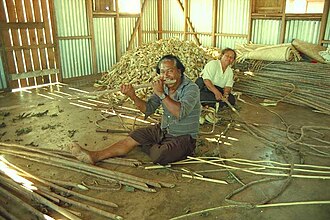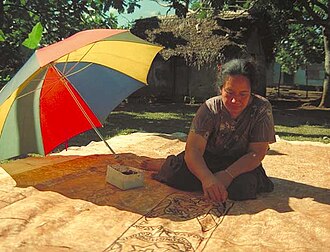AY Honors/Tapa Cloth/Answer Key
Tapa cloth (or simply tapa) is a bark cloth made in the islands of the Pacific Ocean, primarily in Tonga and Samoa, but as far afield as Java, New Zealand, Papua New Guinea and Hawaii. In French Polynesia it has completely disappeared, except for some villages in the Marquesas.
General
tapa cloth is cool The cloth is known bioy a number of local names, although the term tapa is international and understood throughout the islands that use the cloth. The word tapa is from Tahiti, where Captain Cook was the first European to pick it up and to introduce it to rest of the world. In Tonga, tapa is known as ngatu, and here it is of great social importance to the islanders, often being given as gifts. In Samoa, the same cloth is called siapo. In HawaiTemplate:Okinai, it is known as kapa. And in Fiji it is called masi.
All these different words give some clue to the origin. Masi could mean the (bark of the) Dye-fig (ficus tinctoria), endemic to Oceania, and probably the one originally used to make tapa. Somewhere in history, during the voyages of migration the hiapo or siapo was introduced from Southeast Asia, the Paper mulberry tree (broussonetia papyrifera). The bark of this tree is much better to use, and put the use of the Dye-fig into oblivion. Only its name remained in Fiji. Tapa finally, has the meaning of border or strip. It seems likely that before the glueing process became common to make large sheets (see below) only narrow strips were produced.
Tapa can be painted. The patterns of Tongan, Samoan, and Fijian tapa usually form a grid of squares, each of which contains geometrical patterns with repeated motifs such as fish and plants, for example four stylised leaves forming a diagonal cross. Traditional dyes are usually black and rust-brown, although other colours are also known.
In former times the cloth was primarily used for clothing, but now cotton and other textiles have replaced it. The major problem with tapa clothing is that the tissue is just like paper: it looses all its strength when wet and falls apart. Still it was better than grass-skirts, which usually are either heavier and harder or easily blown apart, but on the low coral atolls where the mulberry does not grow, people had no choice.
Nowadays tapa is still often worn on formal occasions such as weddings. Another use is as blanket at night. It is also highly prized for its decorative value and is often found used to hang on the walls as a decoration. In Tonga a family is considered poor, no matter how much money they have, if they do not have any tapa in stock at home to donate at life crises like marriages, funerals and so forth. If the tapa was ever donated to them by a chief or even the royal family, the more valuable it is.

Fabrication
As Tonga is the country where tapa is still a part of daily life, the following description is given for that country. Although on other islands the overall process is about the same, there still might be several smaller or larger differences.
In Tonga hiapo is the name given to the paper-mulberry tree. People have bunches of them growing in a corner of their plantations. They are cut and brought home where the first task is to strip the bark from the trees. The strips are about hand wide and person long. The wood so left over is named mokofute. The bark consists of 2 layers. In the next step the outer bark is to be scraped or split off from the inner bark. This work is called haTemplate:Okinaalo. The outerbark is discarded, the innerbark, named tutu or loututu, is left over. It is first dried in the sun before being soaked.
[[Image:Tutuoli.jpg|right|thumb|A merry break from beating the tapa in [[Nuku'alofa|NukuTemplate:Okinaalofa]]]] After this, the bark is beaten on a wooden tutua anvil using wooden mallets called ike. In the beating the bark is made thinner and spread out to a width of about 25 cm. This phase of the work is called tutu (or tutua). The mallets are flat on one side and have coarse and fine grooves on the other sides. First the coarse sides are used, and towards the end of the work the flat side (tā-tuTemplate:Okinaa). The continuous "thonk" beats of the tapa mallet is still a normal sound in the Tongan villages. If several women work together they can make a concert out of it. In that case there might be one who tukipotu, beats the end of the tutua to set the rhythm.
When the strips are thin enough, several strips are taken together and beaten together into a large sheet. Some starch from the kumala, or manioke may be rubbed on places which are unwilling to stick. This part of the work is called Template:OkinaopoTemplate:Okinaopo, the glue is called tou and the resulting sheet of tapa is called fetaTemplate:Okinaaki. It then consists of two layers of strips in perpendicular direction, the upper one called lauTemplate:Okinaolunga and the lower one laulalo. A knife or sharp shell named mutu is used to trim the edges, and the pieces fallen off in this process are called papanaki. When the white fetaTemplate:Okinaaki is smoked brown, it is called sala.
Often the women of a whole village work together on a huge sheet of tapa. A donation to the church or their chief at an important occasion. Such sheets are about 3 meters wide and 15, or 30, or sometimes even 60 meters long. The 15 meter pieces are called launima (meaning: five-sheet, because the sheet is 5 squares), and the 30 meter pieces are called lautefuhi.
[[Image:Taparub.jpg|left|thumb|Ready to rub the koka onto the fetaTemplate:Okinaaki in [['Eua|Template:OkinaEua]]]]
Painting
The fetaTemplate:Okinaaki is almost always painted. It then becomes ngatu, the Tongan word for the final product. The painting is done over the whole length, but only the central 2.5 meter in the width direction. On both sides there is an unpainted border of about 20 cm wide, which is called the tapa (in Tonga). In order to paint it, the sheets are first put over a huge wooden drum covered with stencils or kupesi. These stencils are made from coconut front midribs (or any other sticks of a few millimeter thick). These stencils are made in the pattern which will be used. There are a handful of standard kupesi designs, like the 'Pine road' (the road from the palace to the royal cemetery), or the 'Shield of Tonga', or the 'Lion' (the king), or the 'Dove' (the king as ruler), and more abstract figures like the 'Manulua' (2 birds).
The tapa sheet is put over the drum and the women now rub with force a dabber with some brown paint (made from the koka tree (bischofia javanica)) over the sheet. This work is called tataTemplate:Okinai. Where they rub over a rib of the kupesi more paint will stick to that position while very little will stick elsewhere. In this way the basic pattern is put on the sheet. Once a part is done, they lift up the sheet and proceed to the next strip and so forth. Only when the whole sheet has been preprocessed, then it will be spread out on the ground and with a brush (made from pandanus seeds) the women will accentuate the faintly visible marks with some more generous paint, this time made from the tongo, the mangrove (rhizophora mangle). Both koka and tongo paint are always brown, but the latter is much darker. Black is not used in Tonga, although it is characteristic for Fiji.
It is customary that during the paint process lines are drawn on the ngatu along the width every 45 cm or more. The kupesi too are made to the size that they will fit in the divisions thusly made. Such a division is known as langanga and they are numbered (on the blank tapa) from one to as many as needed for the whole length. When a smaller piece of ngatu is needed, the sheet is cut along a langanga division. A 4 to 6 langanga piece is called folaTemplate:Okinaosi. An 8 piece is fātuua, while a 10 langanga piece of ngatu is known as toka hongofulu. Less common are the double fātuua, named fātufā or double of that again, the fātuvalu.
These are the traditional ngatu, as evidenced by the extensive vocabulary used (still many more terms exist). Nowadays for the tourist trade other sizes and designs can be made as well.
References
- Template:OkinaI.F. Helu; Critical essays: Cultural perspectives from the Southseas; 1999

